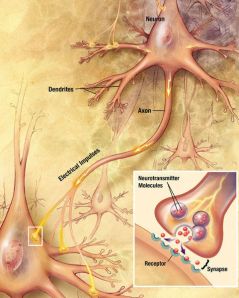By Rebecca Dell
COLUMBIA, Mo. — Wait.
Give it some more time.
Be patient.
When you’re hurting, these words can be hard to hear. The precise causes of depression are not fully known, so treating depression is a multi-dimensional puzzle that includes therapy, medication and time. Doctors often start medication treatment for depression by prescribing a selective serotonin reuptake inhibitor, or an SSRI. Knowing how these antidepressants work can help you understand why these medications take time to show results.
The brain functions with the help of neurotransmitters, which are chemical that act like tiny messengers between nerve cells in the brain. The neurotransmitters leave the end of one nerve cell and fit like a plug into a socket on the next nerve cell, passing on whatever message that neurotransmitter carries.
Serotonin is one of those neurotransmitters. It helps regulate mood, temperature, appetite and sensory perception. It constricts blood vessels and helps you sleep. Serotonin is not the only neurotransmitter implicated in depression — other medications affect other neurotransmitters — but SSRIs specifically affect serotonin.
A lack of serotonin might cause depression, although studies have not confirmed this for sure, says Dr. Ganesh Gopalakrishna, an assistant professor of clinical psychiatry at the University of Missouri Health System. But SSRIs help patients with depression, so serotonin might have a role in depression. SSRI brand names include Prozac, Celexa, Lexapro, Zoloft, Paxil and more. Other neurotransmitters, such as norepinephrine and dopamine, are also implicated in depression, and related treatments are used in therapy.
What do SSRIs do?
When serotonin has done its job and passed its message from one nerve cell to the next, it floats back to the original nerve cell like a kid moving back home after college. To get home, the kid has to walk through the door back into the original nerve cell. SSRIs work by closing those doors. The serotonin, then, heads back out into the real world, or the space between the two nerves. Over several weeks, this causes complex changes on the surface of both the originating cell and the receiving cell. Eventually, these changes can allow more serotonin to be released by the originating nerve cell. The complexity of this response helps explain why different depression symptoms respond to different kinds and combinations of antidepressants.
For a visual representation of what SSRIs do in the brain, see this video from the Mayo Clinic.

This image shows the connecting point between two nerve cells. Courtesy of U.S. National Institutes of Health, National Institute on Aging, via Wikimedia.
What does a typical treatment timeline look like?
It depends. In a seven-year study to evaluate depression treatment, it took an average of six to seven weeks for patients to see depression symptoms disappear when the patients took SSRIs. If one SSRI didn’t work in 12-14 weeks, doctors tried other solutions, including various combinations of medications and counseling. A variety of individual specific factors, including genetics and metabolism, affect how well medications work for each individual. Sometimes patients need to try several combinations before the best one is found.
Originally published March 12, 2014. Edited April 21, 2014



It took months for my medication to work, I started on cytalopram which was brutal, but later was switched to fluoxetine, that suited me better. Without the tablets I wouldn’t have been able to complete my book…they helped me so much
Arran
Hi arran. Can you let me know how many months it took for your meds to work?